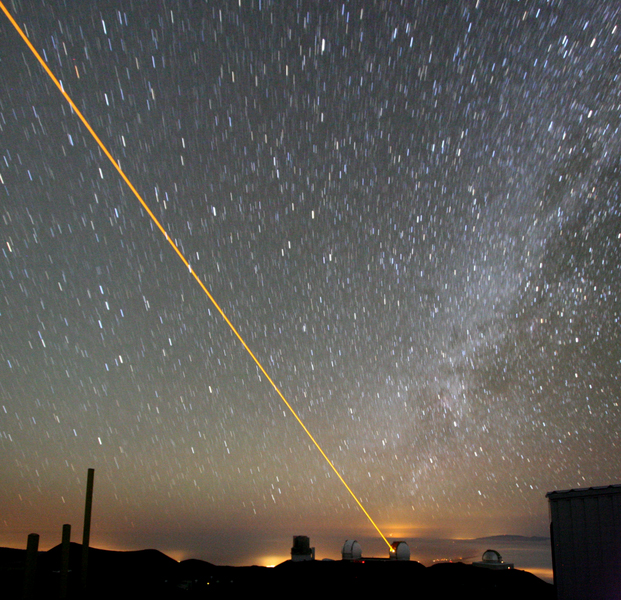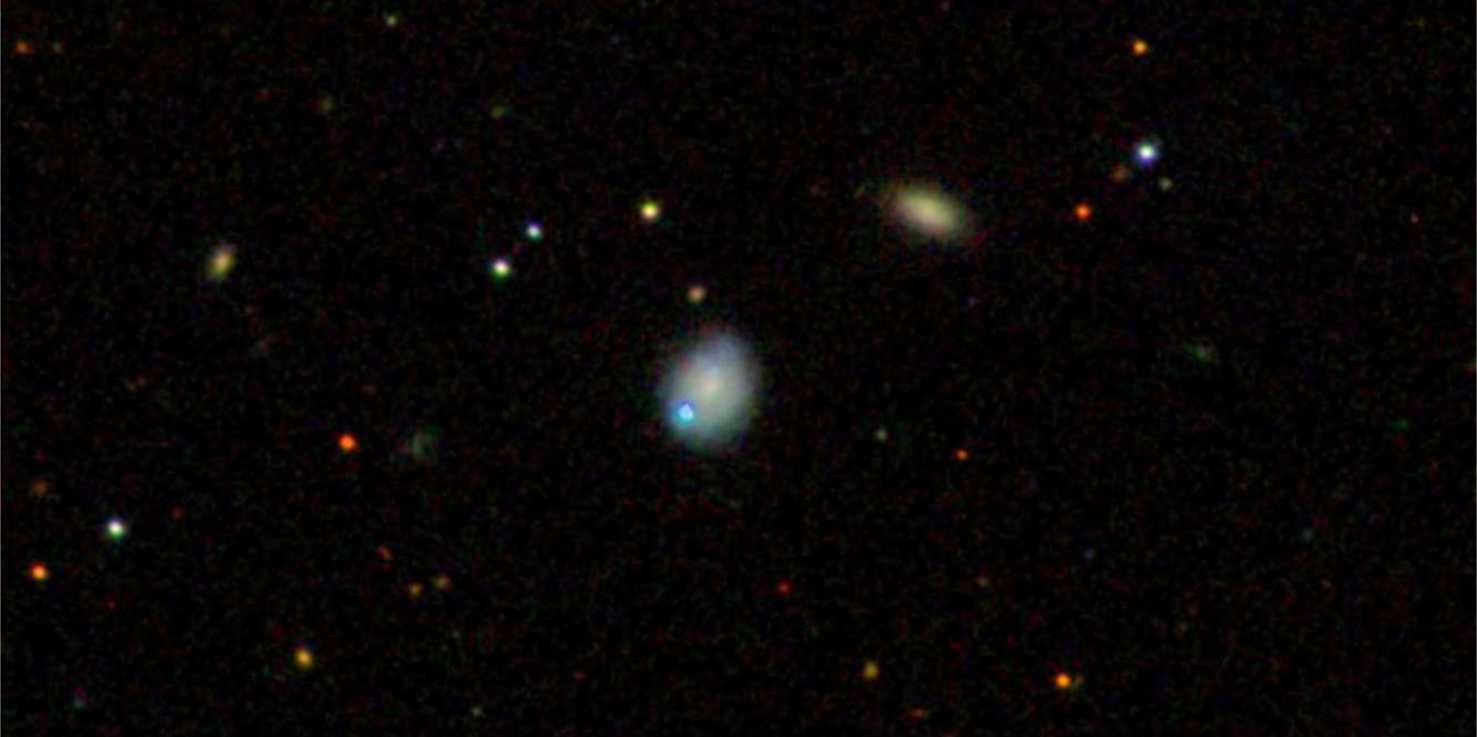A jettisoned black hole?
Astronomers have discovered an object in space that might be a black hole catapulted out of a galaxy. Or it might be a giant star that is exploding over an exceptionally long period of several decades. In any case, one thing is certain: this mysterious object is something quite unique, a source of fascination for physicists the world over because of its potential to provide experimental confirmation of the much-discussed gravitational waves predicted by Albert Einstein.
In his general theory of relativity, Albert Einstein predicted that there are such things as gravitational waves. In fact, the very existence of these waves is the linchpin of the entire theory. Despite the great lengths that physicists have gone to in recent decades, however, they still have not managed to detect them directly with a measurement. This could largely be due to the fact that this requires a level of precision that it is practically impossible to achieve with today’s measuring devices. Ultimately, it is all about measuring the tiniest of compressions and extensions of space which, according to Einstein’s theory, arise when gravitational waves pass through it. And even using the high-precision measuring equipment of the future, only waves with a corresponding level of intensity may well be detectable, such as those formed during the fusion of two merging black holes.
If two galaxies head towards each other in space and eventually collide, they merge into one. The two supermassive black holes in the centre of the two galaxies also fuse. In this process, if the general theory of relativity holds true, gravitational waves are formed and spread out in space. If the black holes have unequal masses or are spinning at different speeds, the gravitational waves will be emitted asymmetrically – giving the fused black hole a “kick” that propels it in the opposite direction. In some cases, this recoil kick is relatively weak and the fused black hole drifts back into the centre. In other cases, however, the kick is strong enough to propel the black hole out of the galaxy entirely, where it will forever wander through the universe.
Remnant of a collision between two galaxies…
Astronomers have been searching for such recoiling black holes, but have not found any strong candidates yet. An international team of scientists including Kevin Schawinski, a professor at the Institute for Astronomy at ETH Zurich, and Michael Koss, a Swiss National Science Foundation Ambizione Fellow working with the Schawinski group, discovered an object that may in fact be a recoiling black hole. The object, named SDSS1133, lies around 90 million light years from Earth, which is nearby in astronomical terms. Researchers from the University of Hawaii, the University of Maryland, the Jet Propulsion Laboratory in Pasadena, California, the University of Arizona, the University of Copenhagen, the University of California, Berkeley, and the Ohio State University have also worked on the discovery.

The researchers first realized that SDSS1133 was a unique object last year, while observing it with a reflecting telescope at the Keck Observatory in Hawaii. Comparisons with an astronomical map from 2001 showed that it was already ten times weaker last year than in 2001 – and although the object was visible on maps from the 1950s and 1990s, it could only be seen very weakly. SDSS1133 shone very brightly in 2001 but did not go completely dark afterwards, which showed that it cannot be a normal supernova – the life-ending explosion of a star – because supernovae tend to be detectable for only a few months before fading significantly.
From a comparison of the wavelength spectrum of the light emitted by SDSS1133 and a nearby dwarf galaxy the scientists concluded that the object might be a black hole that belonged to this dwarf galaxy at one stage and was jettisoned out of it.
… or one of the longest-lived supernovae?
And yet the researchers are far from certain, mainly because there is a second, more exotic possibility: SDSS1133 could be a new type of long-duration outburst before a supernova within a giant star. This giant star would have lost much of its mass in a series of eruptions over the course of at least 50 years before its final explosion.
Scientists have already observed stars changing in this fashion: Eta Carinae, one of the most massive stars in our own galaxy, briefly became the second-brightest star in the sky in 1843. If this type of activity were also the explanation for SDSS1133, that would make it the longest continuous outbursts ever observed before a supernova.
Answers on the horizon
ETH scientists will have the opportunity to search for answers to these questions next year. Black holes and supernovae both emit ultraviolet light, but with differing wavelengths. The researchers have been allocated observation time with the Hubble Space Telescope in October 2015 in order to measure this spectrum more precisely.
Changes in the object’s brightness in the coming years will also give scientists clues as to whether they are dealing with a jettisoned black hole or an exploding mega-star: for a recoiling black hole they expect to see variable brightness, whereas the brightness of a supernova explosion should generally decrease over time. “Whether SDSS1133 is a recoiling black hole or an exploding mega-star, we are observing something that has never before been seen in the universe”, says Michael Koss.
And should they discover that the object is in fact a recoiling black hole, that would considerably increase the odds of one day being able to detect gravitational waves. The scientists estimate that the recoil, if confirmed, occurred around ten million years ago. Consequently, it is not this object in itself that would be important for the concrete measurement of gravitational waves, but rather the fact that it is existing. “Dwarf galaxies are very common,” says Koss. “Therefore it would be highly probable that other recoil events would appear before too long. The hope is that we would be able to observe one near Earth and measure the gravitational waves.”
ESA missions to search for gravitational waves
The European Space Agency (ESA) will use space probes and laser interferometers to detect gravitational waves in space during one of its next large-scale missions, “eLISA”. The launch of the probes has been scheduled for 2034. However, the preparatory mission LISA Pathfinder is already due to blast off next year with a view to testing key technologies for eLISA. ETH Zurich is also involved in LISA Pathfinder (see ETH News report)
Literature reference
Koss M, Blecha L, Mushotzky R, Hung CL, Veilleux S, Trakhtenbrot B, Schawinski K, Stern D, Smith N, Li Y, Man A, Filippenko AV, Mauerhan JC, Stanek K, Sanders D: An Unusually Persistent Transient in a Nearby Dwarf Galaxy, Monthly Notices of the Royal Astronomical Society 2014. 445: 515, doi: external page10.1093/mnras/stu1673call_made

